![]()
![]()
![]()
Use LEFT and RIGHT arrow keys to navigate between flashcards;
Use UP and DOWN arrow keys to flip the card;
H to show hint;
A reads text to speech;
15 Cards in this Set
- Front
- Back
- 3rd side (hint)
|
Velocity |
The rate of change of a particles position r: v = dr/dt The velocity and position are vectors, with both direction and magnitude. the magnitude of the velocity is the speed, v |
|
|
|
Scalar physical property |
(Such as temperature) in general varies through space and is represented by a single value at each point of space |
|
|
|
Vector physical property |
(Such as electric field strength) also varies through space, but in general has a different direction as well as a different magnitude at each point |
|
|
|
Velocity in 3D |
v = vxi + vyj + vzk Where i,j,k are unit vectors, vectors of magnitude 1, pointing along the positive directions on the x, y, z axes and vx, vy, vz are the components of the vector on each axis. The magnitude of the vector is denoted v or |v| and is given by V=(Vx^2 + Vy^2 + Vz^2)^1/2 The vector makes an angle theta with the z-axis and an angle phi to the x-axis in the xy-plane. Vx=V sin(theta) cos(phi)= V (opp/V) (adj/V)= opp (adj/V) Vy=V sin(theta) sin(phi)= V (opp(theta)/V) (opp(phi)/V)= (opp(theta)*opp(phi))/V Vz=V cos(theta)= V adj/V = adj And therefore: Theta = arccos(Vz/V) Phi = arctan(Vy/Vx) |
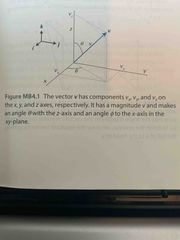
|
|
|
Vector addition, subtraction, and multiplication |
Consider the two vectors u=uxi + uyj + uzk v=vxi + vyj + vzk Addition: v+u=(vx+ux)i + (vy+uy)j + (vz+uz)k Subtraction: v+u=(vx-ux)i + (vy-uy)j + (vz-uz)k Multiplication: The scalar product or the dot product. u.v=uxvx + uyvy + uzvz
|
|
|
|
Linear Velocity |
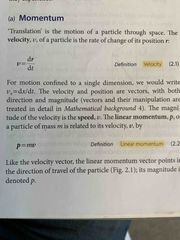
Back (Definition) |
|
|
|
Angular Momentum |
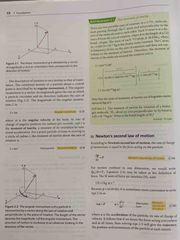
Back (Definition) |
|
|
|
Moment of Inertia |
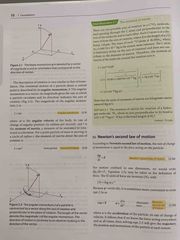
Back (Definition) |
|
|
|
mu =atomic mass constant |
1.66054 X 10^-27 kg |
|
|
|
Newton’s second Law of motion |
The rate of change of momentum is equal to the force acting no the particle. dp/dt = F 1N = 1kg m s^-2 Because p=m(dr/dt) dp/dt=d(m(dr/dt))/dt= m(d^2r/dt)/dt=m(d^2r/dt^2)= ma=F |
|
|
|
Harmonic Oscillator |
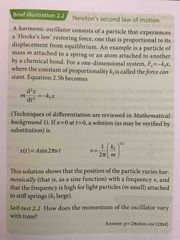
Back (Definition) |
|
|
|
Torque |
The acceleration of a rotation dJ/dt=T J=angular momentum= Iw I= moment of inertia w=angular velocity |
|
|
|
Analogies between translational and rotational |
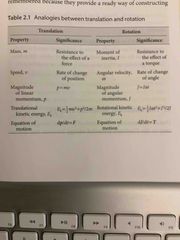
Back (Definition) |
|
|
|
Work |
w, is done in order to achieve motion against an opposing force. For an infinitesimal displacement through ds (a vec- tor) dw=-F*ds where F⋅ds is the ‘scalar product’ of the vectors F and ds F*ds=Fxdx+Fydy+Fzdz For motion in one dimension, we write dw=–Fxdx. The total work done along a path is the integral of this expression, allowing for the possibility that F changes in direction and magnitude at each point of the path. With force in newtons and distance in metres, the units of work are joules (J), with 1J=1Nm=1kgm2 s−2 |
|
|
|
The work of stretching a bond |
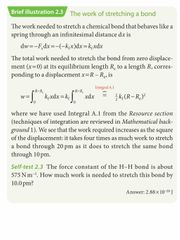
Back (Definition) |
|

